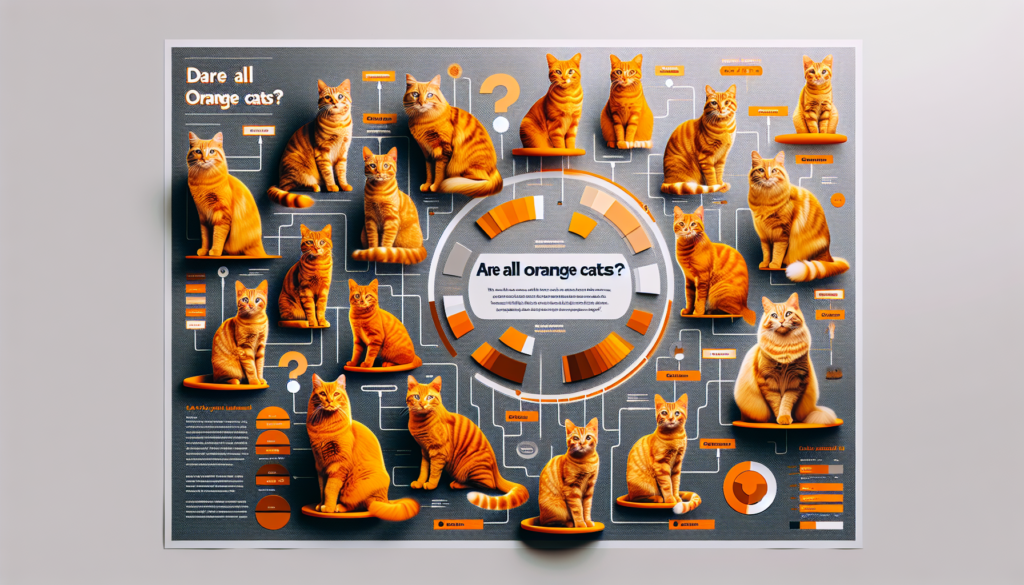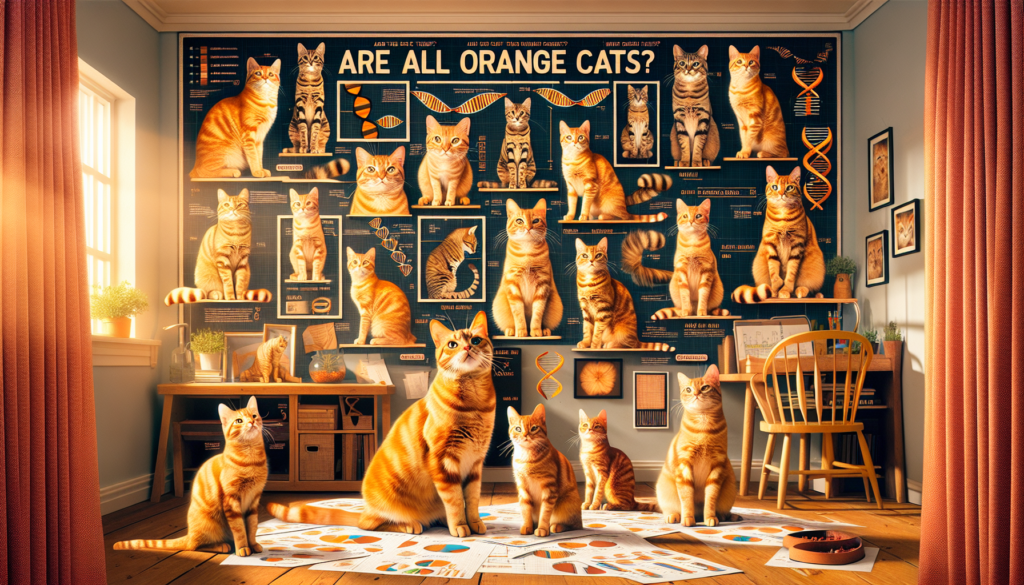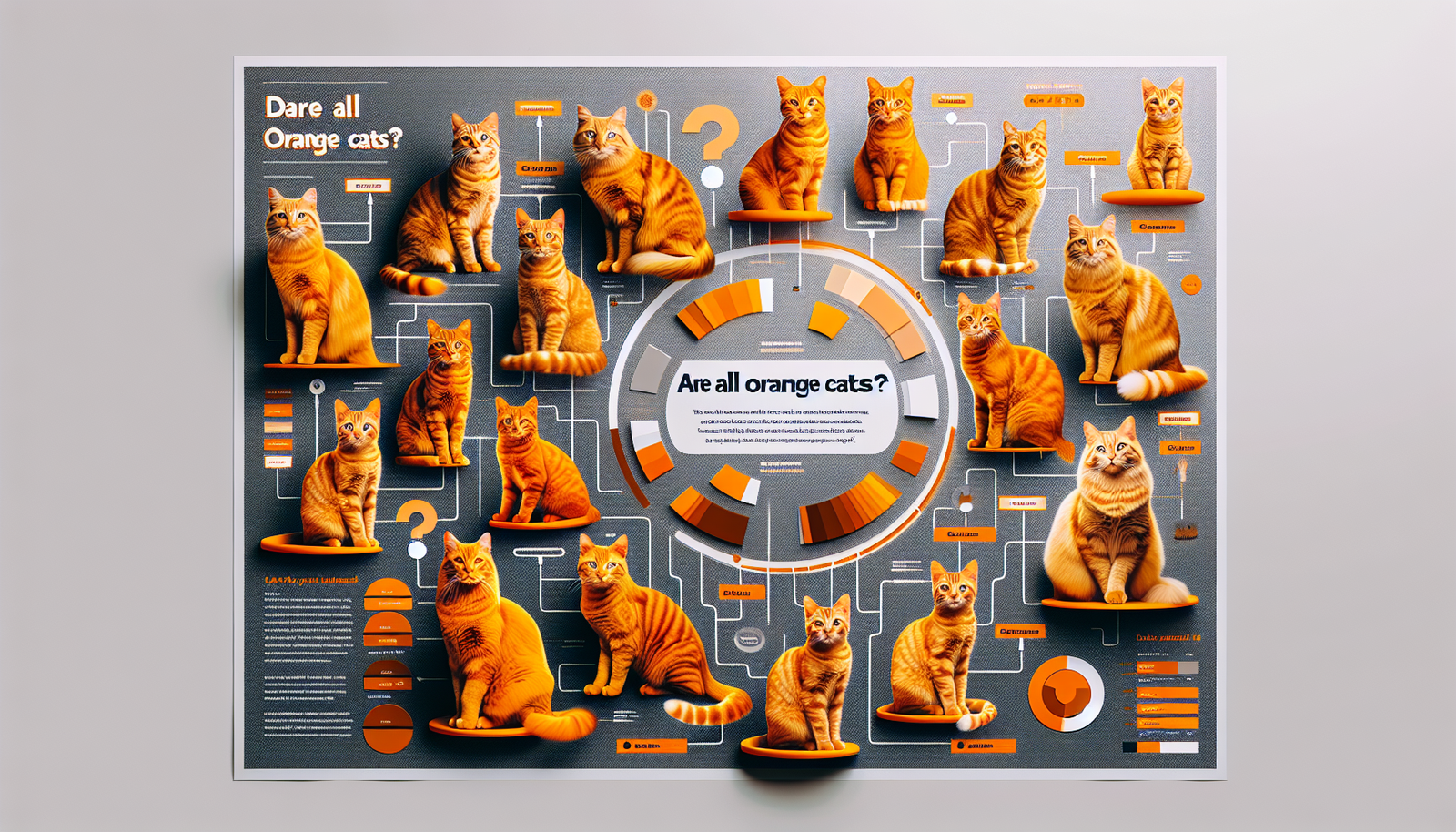Have you ever wondered if all orange cats are tabby? Well, in this article, we will explore the fascinating world of orange felines and uncover the truth behind their unique coat colors. From the iconic Garfield to the mischievous cat next door, orange cats have captured our hearts and piqued our curiosity. So, grab a cup of tea and let’s embark on this delightful journey to discover why not all orange cats are tabby!

Different Coat Colors in Cats
Cats come in a wide variety of coat colors, each unique and beautiful in its own way. While some cats have solid colors, others display striking patterns and combinations. One of the most fascinating coat colors in cats is orange. However, not all cats with orange fur are tabby. In this article, we will delve into the genetic basis of coat color, explore the variations in orange coat color, and uncover the different tabby coat patterns that can be found in cats of various colors.
Genetic Basis of Coat Color
Just like humans, cats’ physical characteristics, including coat color, are determined by their genetics. The genes responsible for coat color in cats are located on their chromosomes. Without getting too technical, two main genes play a significant role in determining the coat colors of cats. These genes are the O (orange) gene and the B (black) gene. The interaction between these genes leads to the wide array of colors and patterns we see in feline coats.
Variations in Orange Coat Color
Orange is a vibrant and eye-catching color that can range from pale cream to rich, deep shades. When it comes to orange cats, their fur color can vary depending on the presence or absence of the tabby gene. Some orange cats have a solid coat color, while others may exhibit tabby patterns. Understanding the genetic basis and inheritance patterns of orange coat color in cats can help shed light on the variations we observe.
Tabby Coat Pattern
The tabby coat pattern is perhaps one of the most recognizable and common patterns among cats. It is characterized by bold stripes, swirls, and spots on the fur, which give the cat a unique and charming appearance. Tabby patterns can be found in cats of various colors, including orange. While not all orange cats are tabby, a significant number of them do display these distinct markings, adding extra flair to their already striking coat color.

Understanding Tabby Cats
Let’s dive deeper into the different types of tabby patterns that can be seen in cats. Each type has its own unique characteristics and traits, making tabby cats even more intriguing.
Mackerel Tabby
The mackerel tabby is the most commonly seen tabby pattern. This pattern is characterized by narrow, vertical stripes that resemble a fishbone pattern. The stripes can be evenly spaced and extend from the spine to the sides of the cat’s body, creating a beautiful and captivating look.
Classic Tabby
The classic tabby, also known as blotched tabby, features large, bold, and well-defined swirls and stripes. These patterns usually form circular shapes on the cat’s sides, giving them an elegant and regal appearance. Classic tabbies are often referred to as “bull’s-eye cats” due to the round shape of their markings.
Spotted Tabby
As the name suggests, spotted tabbies have distinct spots instead of stripes or swirls. These spots can vary in shape and size, ranging from small speckles to larger spots that resemble leopard markings. Spotted tabbies have a playful and wild look that is both unique and captivating.
Ticked Tabby
Ticked tabbies, also known as agouti tabbies, have a unique and intriguing coat pattern. Instead of stripes or spots, their fur appears to be evenly colored with bands of different shades. This gives their coat a textured and subtly captivating look, making them stand out among other tabby patterns.
Patch Tabby
Patch tabbies, also referred to as tortoiseshell tabbies, possess a combination of tabby and tortoiseshell coat patterns. Their fur displays both tabby markings and patches of orange and black, creating a beautiful mosaic-like pattern. Patch tabbies are known for their unique and eye-catching appearance.
Orange Cats and Tabby Patterns
Now that we have explored the various tabby patterns, let’s focus on their relationship with orange cats. Are all orange cats tabby? The answer is no. While many orange cats do exhibit tabby patterns, not all of them possess these distinct markings.
Orange Cats as Tabby
A significant number of orange cats are indeed tabbies. It is believed that the tabby gene (also known as the agouti gene) is responsible for the presence of stripes, swirls, or spots in their fur. The interaction between the O (orange) gene and the tabby gene determines the specific type of tabby pattern seen in orange cats.
Orange Cats without Tabby Patterns
On the other hand, there are orange cats that do not display tabby patterns. These cats may have solid orange fur without any visible stripes, spots, or swirls. The absence of tabby markings in orange cats can be attributed to different genetic factors, which affect the expression of coat patterns.
Ocular Melanosis in Orange Cats
In addition to the variation in tabby patterns, some orange cats may exhibit a unique characteristic called ocular melanosis. Ocular melanosis refers to the presence of dark pigmentation in the iris of the eyes. While this condition is more common in certain breeds, such as the Persian, ocular melanosis can also occur in orange cats. It is important to note that ocular melanosis is usually a benign condition and does not typically affect a cat’s vision or overall health.
Tabby in Non-Orange Cats
While the tabby pattern is commonly associated with orange cats, it is important to recognize that tabby patterns can also be found in cats of other colors. From gray tabbies to brown tabbies and beyond, the tabby gene can present itself in a variety of coat colors. This highlights the versatility and complexity of coat patterns in cats.
Other Factors Affecting Orange Cats’ Appearance
Apart from genetics and the presence of the tabby gene, there are other factors that can affect the appearance of orange cats. These factors can contribute to variations in fur color and patterns, further adding to the diversity within the orange cat population.
Dilution Genes
Dilution genes play a role in modifying the intensity and shade of a cat’s coat color. In orange cats, the effect of dilution genes can lead to variations in the depth and brightness of their orange fur. Some cats may have a lighter, creamier shade of orange, while others may have a deeper, more vibrant hue.
Agouti Genes
While the tabby gene is responsible for the specific tabby patterns seen in cats, the agouti gene plays a larger role in determining the overall appearance of a cat’s coat. The presence of the agouti gene can affect the distribution and visibility of stripes, swirls, or spots in a tabby cat’s coat.
Solid Orange Cats
As mentioned earlier, not all orange cats have tabby patterns. Some cats have solid orange fur without any markings or patterns. These solid orange cats, often referred to as “red cats,” can have a stunning and bold appearance, showcasing the beauty of the vibrant orange color.
Calico and Tortoiseshell Cats
Calico and tortoiseshell cats are known for their intricate and unique coat patterns. While it is less common to see orange calico or tortoiseshell cats, they do exist. These cats possess a combination of orange, black, and white in their fur, resulting in a striking and captivating appearance.
Breeds Known for Orange Cats
While orange cats can be found in various breeds, there are some breeds that are more commonly associated with this stunning coat color. If you’re particularly drawn to orange cats, consider these breeds:
Marmalade Cat
The Marmalade Cat, often depicted in literature and popular culture, is not a specific breed but rather a term used to describe orange cats in general. Marmalade cats can come in different breeds and have a wide range of personalities and traits.
British Shorthair
The British Shorthair is a breed that is often seen in orange coat color. These cats are known for their round faces, stocky build, and plush coats. With their striking orange fur, British Shorthairs make for particularly charming and regal companions.
Maine Coon
The Maine Coon, one of the largest domesticated cat breeds, can also be found in orange coat color. Known for their majestic appearance and friendly personalities, orange Maine Coons are a popular choice among cat lovers seeking a big, lovable companion.
Persian
The Persian breed is famous for its long, luxurious fur and gentle temperament. While Persian cats come in various colors, orange Persians are particularly stunning. Their soft, fluffy coats and sweet expressions make them truly irresistible.
Abyssinian
Although known for their agouti or ticked coat patterns, Abbeyssinians can sometimes be found in shades of red or orange. Abyssinians are active, intelligent cats with a striking appearance. Their warm orange fur adds an extra dimension to their already captivating presence.
Adopting an Orange Cat
If you’re considering bringing an orange cat into your home, it’s important to understand their traits and specific care needs. Here are some key points to consider:
Traits of Orange Cats
Orange cats are known for their friendly and affectionate nature. They often form strong bonds with their human companions and enjoy spending quality time together. Orange cats are generally sociable, adaptable, and make great family pets.
Health Concerns in Orange Cats
Like any other cat, orange cats can be prone to certain health conditions. It is crucial to provide them with proper nutrition, regular veterinary care, and a safe environment to ensure their well-being. Some potential health concerns in orange cats may include dental issues, obesity, and urinary tract problems.
Finding Orange Cats for Adoption
If you’re interested in adopting an orange cat, there are several options available. Local animal shelters, rescue organizations, and breed-specific rescues often have abandoned and neglected cats in need of a loving home. By adopting, you not only provide a second chance to a deserving cat but also experience the joys of feline companionship.
Caring for an Orange Cat
When caring for an orange cat, it’s important to meet their specific needs. This includes providing a balanced diet, regular grooming to maintain their beautiful coat, plenty of mental and physical stimulation, and a safe and enriching environment. Building a strong bond with your orange cat through play, affection, and quality time together is also essential for their happiness and well-being.
Conclusion
In conclusion, orange cats are unique and captivating creatures with a wide range of coat colors and patterns. While not all orange cats are tabbies, a significant number of them exhibit the distinct tabby patterns that add extra charm to their vibrant fur. Understanding the genetic basis and factors that contribute to the appearance of orange cats allows us to appreciate the beauty and diversity within this enchanting group of feline companions. Whether you’re considering adopting an orange cat or simply appreciate their fascinating coat colors, these feline friends are sure to bring joy and warmth into your life.

